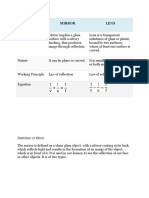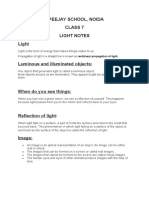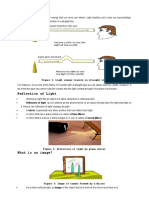Geometric Optics
Geometric Optics
Uploaded by
Yeizmin KimCopyright:
Available Formats
Geometric Optics
Geometric Optics
Uploaded by
Yeizmin KimOriginal Description:
Original Title
Copyright
Available Formats
Share this document
Did you find this document useful?
Is this content inappropriate?
Copyright:
Available Formats
Geometric Optics
Geometric Optics
Uploaded by
Yeizmin KimCopyright:
Available Formats
Geometric Optics
- Study of light.
- Optics is the branch of physics that deals with the behavior of visible light and other electromagnetic
waves.
- Optics is concerned with the generation and propagation of light and its interaction with matter.
Rays
- Indicate the path followed by wave.
Lenses
- A lens is a transparent piece of glass or plastic with at least one curved surface. It gets its name from the
Latin word for "lentil" (a type of pulse used in cooking).
- A lens refracts light and creates an image that is either virtual or real.
Types of Lenses
There are two main types of lenses, known as convex (or converging) and concave (or diverging).
Convex lenses
- In a convex lens (positive lens), the glass surfaces bulge outwards in the center giving the classic lentil-
like shape.
- A convex lens is thicker in the middle than on its outside edge.
- Also called a converging lens because it makes parallel light rays passing through it bend inward and
meet (converge) at a spot just beyond the lens known as the focal point.
- How an image appears in a convex lens depends on the distance and position of the object being viewed.
If an object is within focal distance, it will appear like a "virtual image"--i.e., right side up and larger
than the actual object. An image beyond focal range will appear upside down, and such an image can be
smaller, larger, or the same size as the original image.
Concave lenses
- Outer surfaces curving inward, thicker on the ends and thinner in the middle.
- It makes parallel light rays curve outward or diverge.
- Sometimes called diverging lenses.
- They divert light rays away from a focal point and only create virtual or smaller images.
Difference between Converging and Diverging lenses
Converging Lens Diverging Lens
A converging lens is a lens that converges parallel A diverging lens is a lens that diverges parallel light
light rays coming towards them. rays coming toward them.
It forms the real image It forms the virtual image.
The convex lens is another name for a converging
A concave lens is another name for a diverging lens.
lens.
Convex lens is thicker in the middle and thinner at the Concave lens is thinner at the middle and thicker at
edges. the edges.
Rules for Image Formation
Mirror
- A mirror is a reflective surface that bounces off light, producing either a real image or a virtual image.
How do Mirror work?
- The key factor is a smooth surface, because rough surfaces scatter light instead of reflecting it.
Types of Mirrors
1. Plane Mirror
- A flat mirror that sends light out from itself in multiple directions.
- The point where the reflected light beams intersect is where the image is formed.
- The image formed by a plane mirror will always be the same size as the original object.
2. Convex Mirror
- A convex mirror works like a concave lens.
- It curves light away from its middle.
- Produce only smaller and virtual images.
3. Concave Mirror
- A concave mirror works much like a convex lens.
- It bends light further away in the middle.
Differences between Mirror and Lenses
You might also like
- Cummins - ISC8.3 CM2250 (2010-12)Document14 pagesCummins - ISC8.3 CM2250 (2010-12)Diego Lira100% (3)
- Automatic Acceleration Controlling System in Traffic SignalDocument4 pagesAutomatic Acceleration Controlling System in Traffic SignalBrightchip TechnologiesNo ratings yet
- BAG Technique: Hamima A. Pandapatan CHN Skills-Level II Group ODocument15 pagesBAG Technique: Hamima A. Pandapatan CHN Skills-Level II Group OHamima Azis PandapatanNo ratings yet
- Light: 1.what Are The Types of Mirrors? Lenses?Document1 pageLight: 1.what Are The Types of Mirrors? Lenses?Arniel ToraynoNo ratings yet
- Science ReportDocument4 pagesScience ReportcherlonnclairealigamNo ratings yet
- Difference Between Convex and Concave LensDocument3 pagesDifference Between Convex and Concave LensAmy OliverNo ratings yet
- Physics - Convex LensDocument15 pagesPhysics - Convex LensdivyapriyaNo ratings yet
- Plane and Spherical MirrorsDocument9 pagesPlane and Spherical Mirrorschinkayaby16No ratings yet
- Mirror vs. LensDocument5 pagesMirror vs. LensEhr WinNo ratings yet
- HandoutsDocument2 pagesHandoutsArque John Bertumen AbieraNo ratings yet
- Class 7 Light NotesDocument5 pagesClass 7 Light Noteschotu bhanuNo ratings yet
- Application of Optical Instrument LeCtureDocument14 pagesApplication of Optical Instrument LeCtureNURSHAHADAH ISMAELNo ratings yet
- Assignment No 3Document10 pagesAssignment No 3Moaz RazaNo ratings yet
- Assignment No 3Document10 pagesAssignment No 3Moaz RazaNo ratings yet
- Question 8KdDocument5 pagesQuestion 8KdShihabsirNo ratings yet
- 3 - Dimaano, Jerome M. - LensesDocument6 pages3 - Dimaano, Jerome M. - LensesJerome DimaanoNo ratings yet
- Physics: Nature of Light - Flat MirrorsDocument17 pagesPhysics: Nature of Light - Flat MirrorsReplayableNo ratings yet
- Delhi Public School Nadergul GRADE-10 Physical Science Light - NotesDocument17 pagesDelhi Public School Nadergul GRADE-10 Physical Science Light - Notesbaby doodlesNo ratings yet
- What Is Visible Light Science Presentation in Light Blue Black Hand Drawn StyleDocument21 pagesWhat Is Visible Light Science Presentation in Light Blue Black Hand Drawn StyleJuliusNo ratings yet
- Q2 Module 2 Mirrors and LensesDocument15 pagesQ2 Module 2 Mirrors and LensesIrene DulayNo ratings yet
- 7th LightDocument29 pages7th Lightsmi_santhoshNo ratings yet
- Convex and Concave LensesDocument2 pagesConvex and Concave LensesShandra StinsonNo ratings yet
- Optics 1Document8 pagesOptics 1Stephson Micayee Da LastbornNo ratings yet
- PhysicsDocument30 pagesPhysicsshlokpandey0202No ratings yet
- Theme - Waves Thin LensesDocument11 pagesTheme - Waves Thin Lensespoadcast2023No ratings yet
- Lesson 1 - Image Formation in LensesDocument4 pagesLesson 1 - Image Formation in LensesRhian PanaganeNo ratings yet
- PhysicsDocument27 pagesPhysicsshlokpandey0202No ratings yet
- My FileDocument7 pagesMy Fileمؤمل فاضلNo ratings yet
- Lenses and EYE WorksheetDocument17 pagesLenses and EYE WorksheetarjaNo ratings yet
- CHAPTER 7 Light, Sight and ColourDocument43 pagesCHAPTER 7 Light, Sight and ColourAkmar MataliNo ratings yet
- OpticsDocument63 pagesOpticsJesrel Austria Vidal SarmientoNo ratings yet
- Spherical MirrorsDocument8 pagesSpherical MirrorsJunaid HussainNo ratings yet
- OpticsDocument9 pagesOpticsShrihari DholeNo ratings yet
- ConvexDocument2 pagesConvexKApil BhatiaNo ratings yet
- Concave and Convex LensDocument7 pagesConcave and Convex LensannmarieNo ratings yet
- Lecture Uses MirrorandlensesDocument6 pagesLecture Uses MirrorandlensesdannielmatiasNo ratings yet
- Additional Notes - LightDocument10 pagesAdditional Notes - LightsidharthNo ratings yet
- Refraction Through A Lens PDFDocument3 pagesRefraction Through A Lens PDFPrudhvi JoshiNo ratings yet
- 05 Refraction Through LensDocument149 pages05 Refraction Through Lensaashman.quizzersassembleNo ratings yet
- Mirrors and LensesDocument41 pagesMirrors and LensesMyriel Jean LuigNo ratings yet
- Grade 6 Chapter 6 NoteDocument4 pagesGrade 6 Chapter 6 NotesiyaNo ratings yet
- LightDocument6 pagesLightRenuNo ratings yet
- Concave and Convex LensesDocument11 pagesConcave and Convex Lensesapi-289332586No ratings yet
- LightDocument22 pagesLightPeerchand Chaudhary100% (1)
- Thin LensesDocument37 pagesThin LensesVianca Rein MilanNo ratings yet
- Lenses - An Application of RefractionDocument15 pagesLenses - An Application of RefractionSajol BhadraNo ratings yet
- What Is Light?: Figure 1: Light Always Travels in Straight LineDocument16 pagesWhat Is Light?: Figure 1: Light Always Travels in Straight LineAjitNo ratings yet
- Revision Notes On LIGHTDocument8 pagesRevision Notes On LIGHTTapas Banerjee100% (1)
- LENSDocument55 pagesLENSCristine AtienzaNo ratings yet
- Science 10 Quarter 2 - Module 3: Qualitative Characteristics of Images (REVIEWER)Document4 pagesScience 10 Quarter 2 - Module 3: Qualitative Characteristics of Images (REVIEWER)Ella AuriaNo ratings yet
- Image Formation Through LensesDocument1 pageImage Formation Through LensesDeeksha UpadhyayNo ratings yet
- The Learners Demonstrate An Understanding of The Images Formed by The Different Types of Mirrors and LensesDocument78 pagesThe Learners Demonstrate An Understanding of The Images Formed by The Different Types of Mirrors and LensesWarren Dela CernaNo ratings yet
- Reporting in Science About Curved MirrorsDocument26 pagesReporting in Science About Curved Mirrorsadrian pabyNo ratings yet
- Shedding Light On Curved MirrorsDocument14 pagesShedding Light On Curved MirrorsEyad Ahmed Hanafy Mahmoud TahaNo ratings yet
- Converging Lenses: Made By: Zuhaa AsifDocument7 pagesConverging Lenses: Made By: Zuhaa AsifCherry BlossomNo ratings yet
- LIGHT Notes Class 7Document8 pagesLIGHT Notes Class 7anonymous2344444444444No ratings yet
- Light Mirrors and LensesDocument35 pagesLight Mirrors and LensesdeguzmanjannellegNo ratings yet
- Physic - LensesDocument33 pagesPhysic - Lensesfelitrochristopher924No ratings yet
- Refraction of Light in LensesDocument18 pagesRefraction of Light in Lenseskimberly.tanoNo ratings yet
- Light Refraction and Lenses (Autosaved)Document25 pagesLight Refraction and Lenses (Autosaved)fredNo ratings yet
- Light MirrorsDocument57 pagesLight MirrorsPhylicia RamosNo ratings yet
- I Can See Planets and Stars from My Room! How The Telescope Works - Physics Book 4th Grade | Children's Physics BooksFrom EverandI Can See Planets and Stars from My Room! How The Telescope Works - Physics Book 4th Grade | Children's Physics BooksNo ratings yet
- Acute GastroenteritisDocument54 pagesAcute GastroenteritisVincent LaranjoNo ratings yet
- Psychological Interventions For Overweight or ObesityDocument78 pagesPsychological Interventions For Overweight or ObesityduoraliteNo ratings yet
- Osmena Vs Garganera FullcaseDocument8 pagesOsmena Vs Garganera FullcaseKristanne Louise YuNo ratings yet
- Nikola Tesla A Giant Eye To See Round The WorldDocument4 pagesNikola Tesla A Giant Eye To See Round The WorldBranko StankovićNo ratings yet
- Magnesium Acetyltaurinate As A Photic InhibitorDocument20 pagesMagnesium Acetyltaurinate As A Photic InhibitorTolga AydoganNo ratings yet
- Thermal Control Magazine January 2023 PreviewDocument5 pagesThermal Control Magazine January 2023 PreviewABHISHEK KUMAR SHARMANo ratings yet
- Fourth Sunday of Great LentDocument21 pagesFourth Sunday of Great LentnycxsNo ratings yet
- Nobel Biocare Implant CatalogDocument67 pagesNobel Biocare Implant Catalogk4ssdcNo ratings yet
- 6 Heavy Duty Cooler - Ultra Temp Brochure Rev - 4 FinalDocument13 pages6 Heavy Duty Cooler - Ultra Temp Brochure Rev - 4 FinalSantoshNo ratings yet
- Pinch TechDocument32 pagesPinch TechDaniel Puello Rodelo100% (2)
- Detection of Plasmodium SPP Parasites 1698312917Document1 pageDetection of Plasmodium SPP Parasites 1698312917vickyvania1995No ratings yet
- Bike Insurance 2312100299657800000Document2 pagesBike Insurance 2312100299657800000Sam AntonyNo ratings yet
- PC190 Control Box USER MANUAL 24V DC GEAR MOTOR FOR RESIDENTIAL. Transformer A1 P190-PCB1 SET DOWN R103 R102 R104 R107 R112 R110 R113 R108Document16 pagesPC190 Control Box USER MANUAL 24V DC GEAR MOTOR FOR RESIDENTIAL. Transformer A1 P190-PCB1 SET DOWN R103 R102 R104 R107 R112 R110 R113 R108Alex AlbuNo ratings yet
- AnsiDocument4 pagesAnsijeanyoperNo ratings yet
- Root Meaning Prefix/Suffi X MeaningDocument6 pagesRoot Meaning Prefix/Suffi X MeaningElgin Renz Timbreza RociliNo ratings yet
- Mosconi W1Document14 pagesMosconi W1muzammilbabar91No ratings yet
- Rehabilitation Procedures For A Hamstring TearDocument2 pagesRehabilitation Procedures For A Hamstring TearB W100% (1)
- Example SITE INVESTIGATION REPORTDocument6 pagesExample SITE INVESTIGATION REPORTAmy NazmiNo ratings yet
- Tender Opportunity - Kagita Mikam (Shannonville) CustodianDocument2 pagesTender Opportunity - Kagita Mikam (Shannonville) CustodianKagitaMikamNo ratings yet
- Wpt-III Lab Report 1Document4 pagesWpt-III Lab Report 1Rafid RatulNo ratings yet
- By Mwanza Matthews: Grades 8 and 9 Integrated ScienceDocument53 pagesBy Mwanza Matthews: Grades 8 and 9 Integrated ScienceMusonda SageNo ratings yet
- CH402E - Spot Welding QualityDocument16 pagesCH402E - Spot Welding Qualitylinh caca huynhNo ratings yet
- Seismic Evaluation and Retrofit of Ghaflankouh Historical Railway Masonry Arch BridgeDocument11 pagesSeismic Evaluation and Retrofit of Ghaflankouh Historical Railway Masonry Arch Bridgemohammad safiNo ratings yet
- Silsila e ChishtiaDocument24 pagesSilsila e ChishtiaMustak AhmedNo ratings yet
- Location AnalysisDocument7 pagesLocation AnalysisAhmed ElyazidNo ratings yet
- Crescon Projects and Services Private Limited: Goods Receipt NoteDocument1 pageCrescon Projects and Services Private Limited: Goods Receipt Notecrescon ITC PanchlaNo ratings yet
- Multiprogramming in Operating System - GeeksforGeeksDocument5 pagesMultiprogramming in Operating System - GeeksforGeeksAvin MannNo ratings yet

























































































